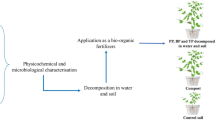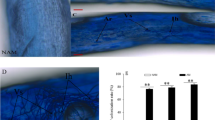Abstract
Pinus pinea L. is a coniferous tree inhabiting the Mediterranean Basin, which appears widely distributed in the Iberian Peninsula, frequently associated to Mediterranean shrub species, such as Cistus salvifolius L., C. libanotis L. and Halimium halimifolium (L.) Willk. (Cistaceae). This study investigated the effects (chemical and physical) of P. pinea needles on the seed germination and early growth of these three shrub species. Laboratory experiments were carried out in order to assess an expected negative effect by using different treatments to seeds (physical layer and two aqueous extracts concentrations). Seed germination of all species was inhibited when treated with aqueous extracts and the degree of inhibition was higher when using the extract with the highest concentration, while no effect was observed with the physical layer treatment. Seedling performance was also sensitive to the different treatments, showing the most stressed values with the high concentration extract. The results from this study highlight the importance of allelopathy of P. pinea needles as a mechanism for controlling seed germination and seedling performance of some Mediterranean shrub species.



Similar content being viewed by others
References
Alrababah MA, Tadros MJ, Samarah NH, Ghosheh H (2009) Allelopathic effects of Pinus halepensis and Quercus coccifera on the germination of Mediterranean crop seeds. New Forest 38:261–272
Bousquet-Melou A, Louis S, Robles C, Greff S, Dupouyet S, Fernandez C (2005) Allelopathic potential of Medicago arborea, a Mediterranean invasive shrub. Chemoecology 15:193–198
Chiapusio G, Sanchez AM, Reigosa MJ, Gonzalez L, Pellissier F (1997) Do germination indices adequately reflect allelochemical effects on the germination process? J Chem Ecol 23:2445–2453
Corral R, Pita JM, Perezgarcia F (1990) Some aspects of seed-germination in 4 species of Cistus L. Seed Sci Technol 18:321–325
Egley GH, Chandler JM (1978) Germination and viability of weed seeds after 2.5 years in a 50-year buried seed study. Weed Sci 26:230–239
Emeterio LS, Arroyo A, Canals RM (2004) Allelopathic potential of Lolium rigidum Gaud. on the early growth of three associated pasture species. Grass Forage Sci 59:107–112
Escudero A, Albert MJ, Pita JM, Perez-Garcia F (2000) Inhibitory effects of Artemisia herba-alba on the germination of the gypsophyte Helianthemum squamatum. Plant Ecol 148:71–80
Facelli JM (1994) Multiple indirect effects of plant litter affect the establishment of woody seedlings in old fields. Ecology 75:1727–1735
Facelli JM, Pickett STA (1991) Indirect effects of litter on woody seedlings subject to herb competition. Oikos 62:129–138
Fernandez C, Lelong B, Vila B, Mevy JP, Robles C, Greff S et al (2006) Potential allelopathic effect of Pinus halepensis in the secondary succession: an experimental approach. Chemoecology 16:97–105
Gallardo A (2001) Descomposición de hojarasca en ecosistemas mediterráneos. In: Zamora R, Pugnaire F (eds) Ecosistemas Mediterráneos. Análisis Funcional. CSIC-España, pp 95–122
Garciaple C, Vanrell P, Morey M (1995) Litter fall and decomposition in a Pinus halepensis forest on Mallorca. J Veg Sci 6:17–22
Geissler K, Gzik A (2010) Germination ecology of three endangered river corridor plants in relation to their preferred occurrence. Flora 205:590–598
Herranz JM, Ferrandis P, Martinez-Sanchez JJ (1998) Influence of heat on seed germination of seven Mediterranean Leguminosae species. Plant Ecol 136:95–103
Hewitt RE, Menges ES (2008) Allelopathic effects of Ceratiola ericoides (Empetraceae) on germination and survival of six Florida scrub species. Plant Ecol 198:47–59
Huang ZY, Dong M, Gutterman Y (2004) Factors influencing seed dormancy and germination in sand, and seedling survival under desiccation, of Psammochloa villosa (Poaceae), inhabiting the moving sand dunes of Ordos, China. Plant Soil 259:231–241
Inderjit S, Dakshini KMM (1990) The nature of the interference potential of Pluchea-lanceolata (Dc) Clarke, C.B. (Asteraceae). Plant Soil 122:298–302
Iovieno P, Alfani A, Baath E (2010) Soil microbial community structure and biomass as affected by Pinus pinea plantation in two Mediterranean areas. Appl Soil Ecol 45:56–63
Izhaki I, Henig-Sever N, Ne’eman G (2000) Soil seed banks in Mediterranean Aleppo pine forests: the effect of heat, cover and ash on seedling emergence. J Ecol 88:667–675
Jefferson LV, Pennacchio M (2003) Allelopathic effects of foliage extracts from four Chenopodiaceae species on seed germination. J Arid Environ 55:275–285
Johnson GN, Young AJ, Scholes JD, Horton P (1993) The dissipation of excess excitation-energy in British plant-species. Plant Cell Environ 16:673–679
Kil BS, Kyeong WY (1992) Allelopathic effects of water extracts of Artemisia princeps var. orientalis on selected plant-species. J Chem Ecol 18:39–51
Lovett JV, Ryuntyu MY, Liu DL (1989) Allelopathy, chemical communication, and plant defense. J Chem Ecol 15:1193–1202
Maestre FT, Cortina J, Bautista S, Bellot J (2003) Does Pinus halepensis facilitate the establishment of shrubs in Mediterranean semi-arid afforestations? For Ecol Manage 176:147–160
Marwood CA, Bestari KTJ, Gensemer RW, Solomon KR, Greenberg BM (2003) Creosote toxicity to photosynthesis and plant growth in aquatic microcosms. Environ Toxicol Chem 22:1075–1085
Maxwell K, Johnson GN (2000) Chlorophyll fluorescence—a practical guide. J Exp Bot 51:659–668
Molina A, Reigosa MJ, Carballeira A (1991) Release of allelochemical agents from litter, throughfall, and topsoil in plantations of Eucalyptus globulus Labill. in Spain. J Chem Ecol 17:147–160
Montero G, Martinez F, Alia R, Candela JA, Ruiz-Peinado R, Canellas I, Mutke S, Calama R (2004) Generalidades de Pinus pinea L. In: Montero G, Candela JA, Rodriguez A (eds) El pino piñonero (Pinus pinea L.) en Andalucía. Ecología, distribución y selvicultura. Consejería de Medio Ambiente, Junta de Andalucía, Sevilla
Moore R (1973) Tetrazolium staining for assessing seed quality. In: Heydecker W (ed) Seed ecology. Butterworths, London, pp 347–366
Muñoz Reinoso JC, Díaz Barradas MC (1992) The ecology of the vegetation of the Asperillo dune system, southwest Spain. Coastal dunes, geomorphology, ecology and management for conservation. Balkema Publisher, Rotterdam, The Netherlands, pp 211–218
Navarro-Cano JA, Barbera GG, Ruiz-Navarro A, Castillo VM (2009) Pine plantation bands limit seedling recruitment of a perennial grass under semiarid conditions. J Arid Environ 73:120–126
Ovando P, Campos P, Calama R, Montero G (2010) Landowner net benefit from stone pine (Pinus pinea L.) afforestation of dry-land cereal fields in Valladolid, Spain. J Forest Econ 16:83–100
Paula S, Pausas JG (2008) Burning seeds: germinative response to heat treatments in relation to resprouting ability. J Ecol 96:543–552
Rachmilevitch S, Huang B, Lambers H (2006) Assimilation and allocation of carbon and nitrogen of thermal and nonthermal Agrostis species in response to high soil temperature. New Phytol 170:479–490
Rashid MH, Asaeda T, Uddin MN (2010) Litter-mediated allelopathic effects of kudzu (Pueraria montana) on Bidens pilosa and Lolium perenne and its persistence in soil. Weed Biol Manage 10:48–56
Rohacek K, Bartak M (1999) Technique of the modulated chlorophyll fluorescence: basic concepts, useful parameters, and some applications. Photosynthetica 37:339–363
Roy J, Sonie L (1992) Germination and population-dynamics of Cistus species in relation to fire. J Appl Ecol 29:647–655
Saxena A, Singh DV, Joshi NL (1996) Autotoxic effects of pearl millet aqueous extracts on seed germination and seedling growth. J Arid Environ 33:255–260
Shui JF, An Y, Ma YQ, Ichizen N (2010) Allelopathic potential of switchgrass (Panicum virgatum L.) on perennial ryegrass (Lolium perenne L.) and alfalfa (Medicago sativa L.). Environ Manage 46:590–598
Tefera T (2002) Allelopathic effects of Parthenium hysterophorus extracts on seed germination and seedling growth of Eragrostis tef. J Agron Crop Sci 188:306–310
Troumbis A, Trabaud L (1986) Comparison of reproductive biological attributes of 2 Cistus species. Acta Oecol-Oec Plant 7:235–250
Wardle DA, Ahmed M, Nicholson KS (1991) Allelopathic influence of nodding thistle (Carduus nutans L.) seeds on germination and radicle growth of pasture plants. New Zeal J Agr Res 34:185–191
Yang HL, Huang ZY, Ye YZ, Zhu XW, Dong M, Weng HB (2010) Effects of soil moisture profile on seedling establishment in the psammophyte Hedysarum laeve in the semiarid Otindag sandland, China. J Arid Environ 74:350–354
Zunzunegui M, Díaz Barradas MC, García Novo F (2000) Different phenotypic response of Halimium halimifolium in relation to groundwater availability. Plant Ecol 148:165–174
Acknowledgments
We thank the Seville University General Glasshouse for their collaboration. We also thank Dr. Juan Jáuregui Arana for his helpful comments in order to improve the English of the manuscript. This research was supported by a fellowship from the University of Seville. The managing editor of this journal, Dr. Manoj Kulkarni, and two anonymous referees offered suggestions that have greatly improved the paper.
Author information
Authors and Affiliations
Corresponding author
Rights and permissions
About this article
Cite this article
Valera-Burgos, J., Díaz-Barradas, M.C. & Zunzunegui, M. Effects of Pinus pinea litter on seed germination and seedling performance of three Mediterranean shrub species. Plant Growth Regul 66, 285–292 (2012). https://doi.org/10.1007/s10725-011-9652-4
Received:
Accepted:
Published:
Issue Date:
DOI: https://doi.org/10.1007/s10725-011-9652-4




